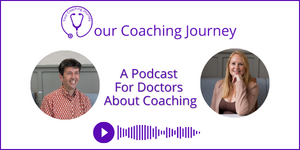Prefer to listen?
This blog post forms the basis of a podcast on our new coaching model, which you can listen to here.
Clean Language is an approach that really focuses on the metaphors that our clients bring up in the coaching conversation.
Where does Clean Language as an approach to coaching originate from?
It started with David Grove, a psychotherapist living in New Zealand in the 1980s. He was also a counselling psychologist, interested in trauma, and had done a lot of work with Vietnam War veterans. He had an interest in neurolinguistic programming, hypnotic language, the person-centred approach, and a bit of inner child work. He had lots of different interests and integrated them into what became Clean Language.
Having been quite integrative, he narrowed down his practice to something very niche, but useful in some ways.
His main interest was in traumatic memories and phobias, and he found that many of the war veterans he worked with couldn’t remember the experience they’d had, but they felt the emotions, and the triggering of emotion. What he found was, if he left them to their own devices, they would naturally talk in metaphor about the experience whilst not talking about the specific thing. He thought there was something in that. He also became interested in the language that therapists used, people like Carl Rogers and Virginia Satir, and analysed what they were doing.
Fortunately for him, Carl Rogers used to record his sessions, so there was quite a lot of evidence of how he operated. As we’ve talked about before in the person-centred approach, Carl Rogers didn’t ask a lot of questions. He did a lot of playing back. David Groves’ thoughts on this were that in playing back, Carl Rogers would use his own language, and perhaps frame it in a different way. He wouldn’t be precise about the language he was using, he would just reflect what he thought. Grove’s notion was that this was hijacking the client’s own thinking and taking something away from what they were describing the situation as. If they were using a metaphor and you then played it back using literal terms, you took away from their experience. So he became very interested in just focusing on the client’s experience and the metaphors that they were sharing.
How did Clean Language Evolve?
David Grove had about 20 years of expanding on his theory. There are some videos of him on YouTube, so it’s worth going back and watching him in action. You’ll find that he talks very slowly and in quite a hypnotic way.
There’s quite a bit of interest in this different approach to working with people and their stories and in therapy, so a number of other therapists started to become interested. James Lawley, and his partner, Penny Tompkins, spent 12 years working with him, studying him and what he was doing. As much as Grove analysed Carl Rogers, they analysed what Grove was doing in the coaching room and the questions he was asking. They started to code some of that and create a bit of a script for it. Caitlin Walker, Marin Way, and Judy Rees are all people that have been active in bringing clean language to different places. For example, Caitlin Walker is very interested in using clean language in education, Judy Rees is involved in the IT world. It’s almost like there’s this community of clean language advocates that go off in their own different directions and introduce it to their environment. But coaching is obviously a place where it fits quite nicely.
Caitlin Walker has a wonderful TED talk that she did about her work with adolescents who were struggling, perhaps in an education environment and using metaphor to help draw them out of themselves. It is quite powerful to watch.
Other than the coachee’s own language and metpahor, what else distinguishes Clean Language from other forms of coaching?
The fact that it’s not really a conversation as such, there is just a set of questions that you ask. Depending on where you look for this information, there are between 10 and 20 questions that you might ask. At a very basic level, there’s around 10 questions you ask.
What would you like to have happen?
That is a question that we both ask often in our coaching. It’s a powerful question. It breaks through where perhaps someone’s stuck in their situation and not seeing a way out and are just focused on the problem or what they don’t want. ‘What would you like to have happen? lifts them out of that.
And what kind of … is that …?
Then, let’s say someone was looking for some clarity, you would ask, ‘And what kind of clarity is that clarity?
Again, that’s a question we quite often use because it stops people. It might sound a bit of a clunky question but in the context of a coaching conversation it makes people stop and pause and think, It’s another way of delving in a bit deeper about someone’s situation.
Then they would ask,
And is there anything else about …?
‘And is there anything else about clarity?’
We find that question really odd because it’s a closed question. We don’t ask close questions. We might ask someone, And what else is there about that clarity?
Interestingly, we met James Lawley, and asked him why do you ask a closed question? Because in coaching, we just don’t do that. He said it was because we don’t want to put pressure on the person to come up with something that isn’t there.
We think that in asking an open question, ‘And what else is there?’, they’re perfectly able to say, there isn’t anything else if there isn’t. And you would get them to think a bit deeper and think a bit longer about what else there might be about that thing.
Helen was on a Clean Language workshop where she observed someone shut down their thinking because they were asked this question. She knew he had had more to say, because she had been working with him, but the minute this question was asked, he simply said ‘No’. We’re not Clean Language coaches, but we aren’t fans of this question!
Back to clean language… they might ask this question more than once until there isn’t anything else.
And where is …?
Going back to David Gross, he was a therapist, and he was very interested in the embodied experience of whatever was going on. Obviously, working with people with trauma, they might well feel it somewhere. If you ask them, ‘And where is that clarity?’ They might point to a place on their body. That’s what he was really interested in. Was it inside them or outside them? That became part of the clean language approach is finding out where something was.
By asking where it is as opposed to where is it in your body we are asking a more open, nuanced question, because it might not be in someone’s body. If someone’s searching for clarity, clarity might be over there in the corner, and they can’t quite reach it.
And then to find out more, they would ask,
And does it have a size?
And what size is it?
And does it have a shape?
And what shape is it?
Then we get to explore the situation around that thing:
And what happens next?
And then what happens?
And what happens just before …?
These questions help to build a picture of what happens around the thing that the client is speaking about. It remind us a bit of a Cognitive Behavioural approach, so we could start to get a picture of triggers and responses or reactions.
When that happens, then what happens?
When clarity, then what happens?
Further questions are:
And where could … come from?
And where might clarity come from?
And that’s … like what?
And that’s clarity like what?
This is another question designed to elicit a metaphor rather than saying, ‘what’s the metaphor for this?’
Because if you were to say to someone, What’s the metaphor for that? Then they’re in that thinking, rational space. Whereas if you’ve gone through all of this process and then invite, ‘and that’s clarity like what?’ you’re almost in a creative space where you’ve gone under the radar of the conscious thinking, rational mind, and you’re into more of a subconscious way of thinking. We start to dig down into more depths with that.
Clean Language Can Be Really Powerful
We’ve definitely seen it work. The only thing is, we’ve seen it work by people who are experts. James Lawley spent 12 years with David Grove and really honed his skills. By the time he came to our conference, he’d I’ve really been immersed in this for 20 years and was an expert. And when he did his demonstration of it at our conference, it was masterful. It just really worked. we’ve seen other people that claim to be clean language exponents, where it just seems clunky and doesn’t seem to go anywhere. And it’s not quite smooth enough and perhaps doesn’t get to the place that you thought it might get to.
We think it’s deceptively difficult. Here’s a set of 10-20 questions. If you just ask these questions all will be well in the world and you’ll elicit the metaphors that are going to change someone’s life, possibly. But it takes a lot of time to get to that place. We know people in the clean language world, but they don’t just use Clean Language as a coaching approach. They integrate it into their approach. It’s quite a niche coaching practise and quite a small community. Probably because it is very difficult to become really good at it.
Two Key Observations on the Language of Clean Language
There are a couple of interesting elements of the language that gets used in this approach. Firstly, they use the word ‘that’. ‘What clarity is that clarity, which distracts people perhaps away from the word clarity. It makes people think a little bit deeper when you say that clarity.
They also use the word ‘and’ when they come in after someone has finished speaking. ‘And when you have clarity, what clarity is it?’ And would always proceed the question so that it’s a follow on of the client talking. It’s almost slightly hypnotic in the way that it’s done.
How then do we move forward in that thinking?
We’ve asked, ‘what would you like to happen?’ What would that be? What would he look like? What size, what shape, et cetera? But there doesn’t seem to be a step towards that. In the way that we would look at options and how are you going to move towards where you want to be, is that missing from this approach?
Clean Language is about someone getting a deeper understanding of where they are and what their situation is.
Here’s Tom’s example of using it within a coaching session:
- I worked with a lady who, when she talked about having a weight on her shoulder,
- I asked her, What weight is that weight?
- She said, It’s a concrete block. It’s a grey concrete block.
- I said, It sounds really heavy, (which is not Clean, that’s me implying it’s heavy.)
- But she said, No, it’s really heavy.
- I said, Where does the concrete block need to be?
- And she said, I need it off my shoulder. I need it in front of me so I can see it.
- I said, Okay, so if you take the concrete block off your shoulder and let’s have it in front of you. It’s now in front of you. Tell me more about the concrete block.
- So she described it and she said, well, it’s made up of smaller blocks. And I think what I could do is take some of those blocks out, move them to one side, and leave them for later, and just use the blocks that are useful for me now. And those blocks aren’t discarded. I’m putting them to one side, but I think I could use them later. I don’t think I’m going to lose them entirely.
And that, for her, during COVID, was all about taking some education product from the classroom, online. And she was fantastic in the classroom and thought she was going to fail miserably online. So was wondering what she could leave out because all her stuff was brilliant. It gave her that opportunity to think about it in a different way.
That’s taking Clean Language and being inspired by it rather than following the script. What happens when we use only the clean language script?
You can listen to us working through a script we borrowed from a clean language website here at 19 minutes 48 seconds
Let’s Explore This Coaching Session:
Obviously, this is a script, but assuming it’s based on a real coaching conversation, what’s interesting is that someone came up with the metaphor of this steel tube as a way of giving them foundation, some structure, something solid that they could then take forward from there. This person now has something solid that they can then take forward, they don’t need to generate options and choose their next step. Those realisations that have come about as a result of talking through the metaphor are useful to them in taking things forward.
In that script there were nine questions asked, and four of them were, ‘is there anything else about?’ Three were, ‘what x is that x?’ One was, ‘what would you like to have happen?’ And one was, ‘where is that?’ So, we’re only using four questions, but we’re repeating them.
And it’s not simply asking the set of 10 questions in one specific order, so, it’s not a script in that sense. But those are the types of questions that you might well ask.
Effectively, these are the only questions or types of questions that you can ask in this coaching session and how you ask them, the order in which you ask them, which things you pick up on, which metaphors you pick up on, that’s for you as a coach, to decide.
That is the art of it.
With time and experience, you get to know which words to focus on.
We’ve both certainly played with this approach and introduced elements of it into our coaching, especially working with metaphors.
What we’re unsure about is whether you need more.
But we feel it’s definitely something that’s worth looking at and potentially integrating into your coaching. Some of those questions can start to elicit some beautifully rich metaphors from our clients, if that’s how they think.
But what about if someone doesn’t think in metaphor? It may not work.
If you like the sound of some of these questions, maybe you’ll borrow them and try them out, although, perhaps don’t borrow the closed ones!
To find out more about our Doctors’ Transformational Coaching Diploma click through here



